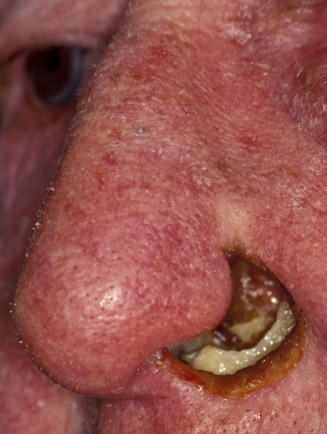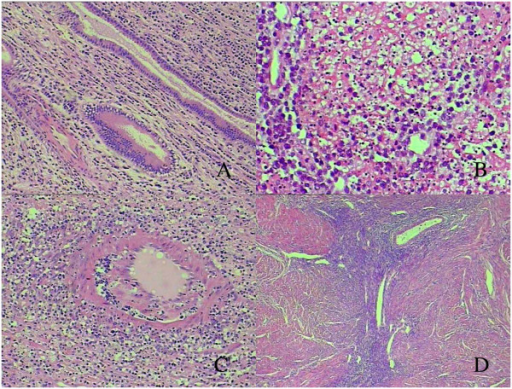Extranodal NK-T-cell lymphoma pathophysiology
|
Extranodal NK-T-cell lymphoma Microchapters |
|
Differentiating Extranodal NK-T-cell lymphoma from other Diseases |
|---|
|
Diagnosis |
|
Treatment |
|
Case Studies |
|
Extranodal NK-T-cell lymphoma pathophysiology On the Web |
|
American Roentgen Ray Society Images of Extranodal NK-T-cell lymphoma pathophysiology |
|
Risk calculators and risk factors for Extranodal NK-T-cell lymphoma pathophysiology |
Editor-In-Chief: C. Michael Gibson, M.S., M.D. [1]; Associate Editor(s)-in-Chief: Ramyar Ghandriz MD[2] Sowminya Arikapudi, M.B,B.S. [3]
Overview
Most tumors involve NK cells but also involve T cells as neoplastic cells, that is the main reason of classification as NK/T-cell lymphoma rather than NK-cell lymphoma.Natural killer cells are a type of lymphocyte that is closely related to T cells and attack foreign cells. On gross pathology, angiocentric and angiodestructive pattern of growth with associated geographical necrosis and ulceration are characteristic findings of extranodal NK-T-cell lymphoma. On microscopic histopathological analysis, medium-sized tumor cells and polymorphic infiltrate of nonneoplastic inflammatory cells are characteristic findings of extranodal NK-T-cell lymphoma.[1][2]
Pathophysiology
Physiology
- NK cells are CD3 and myloperoxidase negative on their surface.[3]
- NK cells have germline configuration of T-cell receptor and immunoglobulin genes.
- NK cells originate from a bipotent NK/T-progenitor cell so they have a lot in common with T cells.
- NK cells express T-associate markers such as CD2, CD3e, CD7, CD8, CD16, CD56, CD57.[4]
- Most tumors involve NK cells but also involve T cells as neoplastic cells, that is the main reason of classification as NK/T-cell lymphoma rather than NK-cell lymphoma.
Immunotype
- The immunophenotype of NK lymphoma cells is classically positive for CD2, CD56, and cytoplasmic CD3 epsilon.
- They are negative for surface CD3. Unlike normal NK cells, the tumor cells are usually negative for CD7 and CD16.
- They express cytotoxic granule associated proteins granzyme B, T-cell restricted intracellular antigen (TIA-1), and perforin.
- NK/T cell lymphoma expressing CD56 is rare but most commonly occurs int he head and neck region, skin, and soft tissue.[5]
Gross Pathology
- On gross pathology, angiocentric and angiodestructive pattern of growth with associated geographical necrosis and ulceration are characteristic findings of extranodal NK-T-cell lymphoma.
- Coagulative necrosis and apoptotic bodies are frequently encountered.
- Extranodal NK/T-cell lymphoma, nasal type occurs in nasal cavity and upper aerodigestive tract.
- Extranodal NK/T cell lymphoma, nasal type affects the nose and facial mid line exhibiting aggressive destruction.

Microscopic Pathology
- On microscopic histopathological analysis, medium sized tumor cells and polymorphic infiltrate of non-neoplastic inflammatory cells are characteristic findings of extranodal NK-T-cell lymphoma.
- The tumor cells are small to medium in size with occasional large and anaplastic forms.
- The lymphoma cells may be admixed with a polymorphic infiltrate of nonneoplastic inflammatory cells including small lymphocytes, plasma cells, histiocytes, and eosinophils.

References
- ↑ Extranodal Natural-Killer/T-Cell Lymphoma, Nasal Type. Hindawi Publishing Corporation. http://www.hindawi.com/journals/ah/2010/627401/. Accessed on February 18, 2016
- ↑ Extranodal NK/T-cell lymphoma, nasal type. Canadian Cancer Society. http://www.cancer.ca/en/cancer-information/cancer-type/non-hodgkin-lymphoma/non-hodgkin-lymphoma/types-of-nhl/extranodal-nk-t-cell-lymphoma-nasal-type/?region=on. Accessed on February 19, 2016
- ↑ Ham, Maria Francisca; Ko, Young-Hyeh (2010). "Natural killer cell neoplasm: biology and pathology". International Journal of Hematology. 92 (5): 681–689. doi:10.1007/s12185-010-0738-y. ISSN 0925-5710.
- ↑ Stewart CA, Walzer T, Robbins SH, Malissen B, Vivier E, Prinz I (2007). "Germ-line and rearranged Tcrd transcription distinguish bona fide NK cells and NK-like gammadelta T cells". Eur J Immunol. 37 (6): 1442–52. doi:10.1002/eji.200737354. PMID 17492716.
- ↑ Ko, Y H; Cho, E-Y; Kim, J-E; Lee, S-S; Huh, J-R; Chang, H-K; Yang, W-I; Kim, C-W; Kim, S-W; Ree, H J (2004). "NK and NK-like T-cell lymphoma in extranasal sites: a comparative clinicopathological study according to site and EBV status". Histopathology. 44 (5): 480–489. doi:10.1111/j.1365-2559.2004.01867.x. ISSN 0309-0167.
- ↑ . doi:10.3205/cto000119. Missing or empty
|title=(help) - ↑ Fang, Jian-chen; Zhou, Jue; Li, Zheng; Xia, Zhao-xia (2014). "Primary extranodal NK/T cell lymphoma, nasal-type of uterus with adenomyosis: a case report". Diagnostic Pathology. 9 (1). doi:10.1186/1746-1596-9-95. ISSN 1746-1596.